
This is free.
Douglas-fir research Specialty Wood Products Research Partnership
Marco Lausberg and Harriet Palmer, New Zealand Tree Grower May 2022.
This article contains more detail about research on Douglas-fir carried out by the Specialty Wood Products Research Partnership. Work on new products and their application has laid foundations for future market development, while breeding work will benefit growers once the targeted gains materialise. The Specialty Wood Products Research Partnership is a seven-year Ministry for Business and Innovation and industry-funded research programme which draws to a close in June.
The New Zealand resource
Douglas-fir Pseudostuga menziesii is New Zealand’s second most popular plantation species after radiata pine, covering an estimated 97,580 hectares. The main planting is concentrated in colder, wetter parts of New Zealand.
- Around 80 per cent of the total area of Douglas-fir is in the South Island – 78,950 hectares
- Almost 75 per cent of the South Island Douglas-fir is in Otago and Southland – 58,600 hectares.
- Significant areas are also found in the central North Island with over 16,600 hectares, and in the Nelson- Tasman region with around 6,500 hectares.
The age distribution of Douglas-fir reflects high levels of planting in the 1990s and early 2000s. This planting peak was especially marked in Southland. These trees are now in mid rotation and represent a valuable future resource. Meanwhile, over 1.4 million cubic metres of Douglas-fir were harvested in the year ending March 2021, around four per cent of the total 34 million cubic metres of the annual New Zealand harvest.
Distribution of Douglas-fir by age class and island
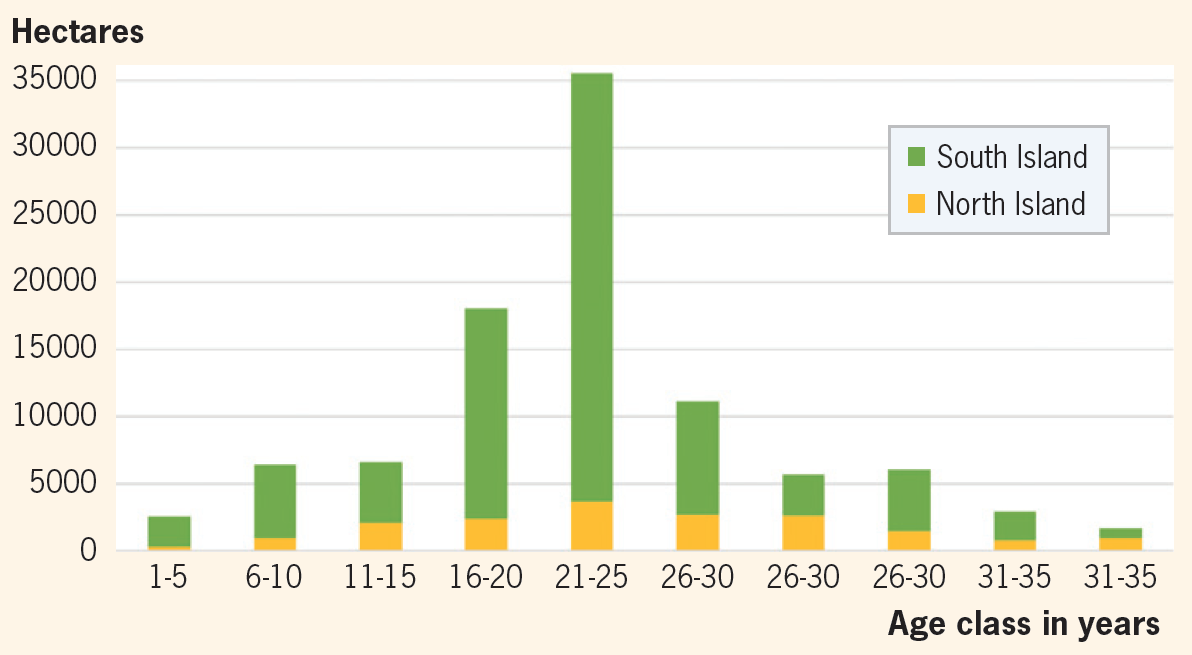
A short history of Douglas-fir research
Douglas-fir was introduced into New Zealand in 1859 and first planted at Mt Peel Station in Canterbury. This was around 32 years after Scottish botanist David Douglas sent seeds from North America back to Scotland, and the species was planted on some Scottish estates. The UK’s tallest trees are now some of that early Scottish Douglas-fir planting, a few of which are over 66 metres tall.
Douglas-fir was selected early on by the Forest Service as a potential timber species. From the 1930s, large-scale planting was established grown from Washington State seed. Since then, Douglas-fir has been an important secondary species in New Zealand plantation forestry, especially in the southern South Island. Its strengths include steady growth rates on colder, wetter sites, and its ability to tolerate snow and storms with little damage. It can occupy sites more densely, with a higher basal area than radiata pine and produces timber with superior stiffness and structural qualities.
Douglas-fir has an extensive natural range in the western United States. In the 1950s the Forest Research Institute established a series of New Zealand-wide provenance trials with seeds from California, Oregon and Washington. By the 1970s, assessment of these trials indicated that coastal Californian and southern Oregon provenances grew better than the original Washington ones. Seed collection and breeding work based on provenances from this western United States fog-belt then continued into the 1980s, led by seed company Proseed NZ in collaboration with the Forest Research Institute.
Changes in ownership
The Forest Service established over 60,000 hectares of Douglas-fir. After the demise of the Forest Service in 1987, new private owners were instrumental in expanding the area of Douglas-fir and setting up the New Zealand Douglas-fir Growers’ Co-operative in 1993. There was strong support from industry for research. The co-operative was also linked to a North American co-operative, and the two organisations worked together on breeding and growth modelling. Other research included work on timber properties, processing, and silviculture.
The Specialty Wood Products Research Partnership was formed as part of Forest Growers Research in 2015, and the Douglas-fir Co-operative was merged into the structure. Leading South Island Douglas-fir growers Ernslaw One and Blakely Pacific are partners, along with several central North Island growers. Douglasfir research receives around 21 per cent of the total Specialty Wood Products Research Partnership budget.
The programme identified two main research areas –
- Improving returns from trees already in the ground by developing new products and adding value
- Breeding programmes to improve the potential to grow trees which will be easy to process and meet market demands.
New product development and testing
Cross-laminated timber
The demand for engineered wood for medium and high-rise construction is a global growth area, and cross-laminated timber has potential in this market. Douglas-fir has been identified as being well-suited as a component of cross-laminated timber. New Zealand grown Douglas-fir was processed by a Nelson company on a trial basis, and then taken to the University of Canterbury Department of Engineering for comprehensive testing. An Australian company, Xlam, based in Albury, also made a batch of Douglas-fir crosslaminated timber for testing.
Earlier Tree Grower articles have reported on this work by Minghao Li, in November 2018 and August 2021. Dr Li’s team tested panels for structural properties and concluded that it would meet the required standards for use in construction – in other words, the Douglas-fir cross-laminated timber could substitute for that made using radiata pine or other species.
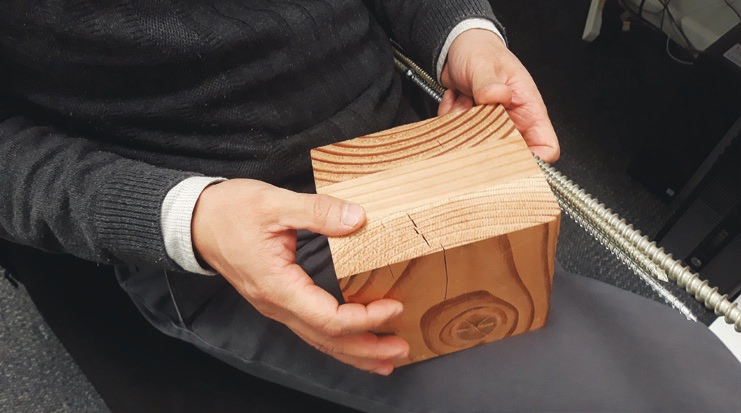
Screw connectors and a Douglas-fir cross laminated timber sample
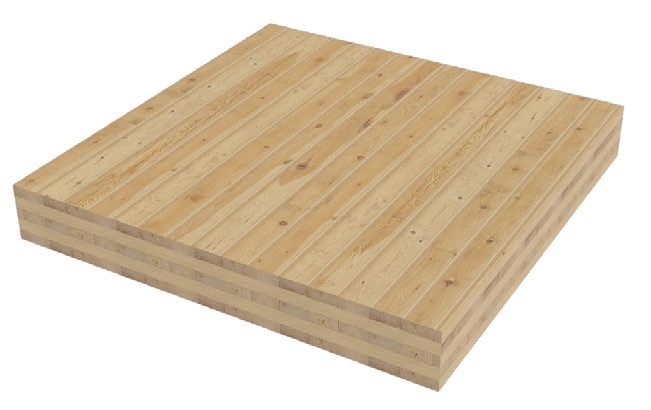
Generic cross-laminated timber
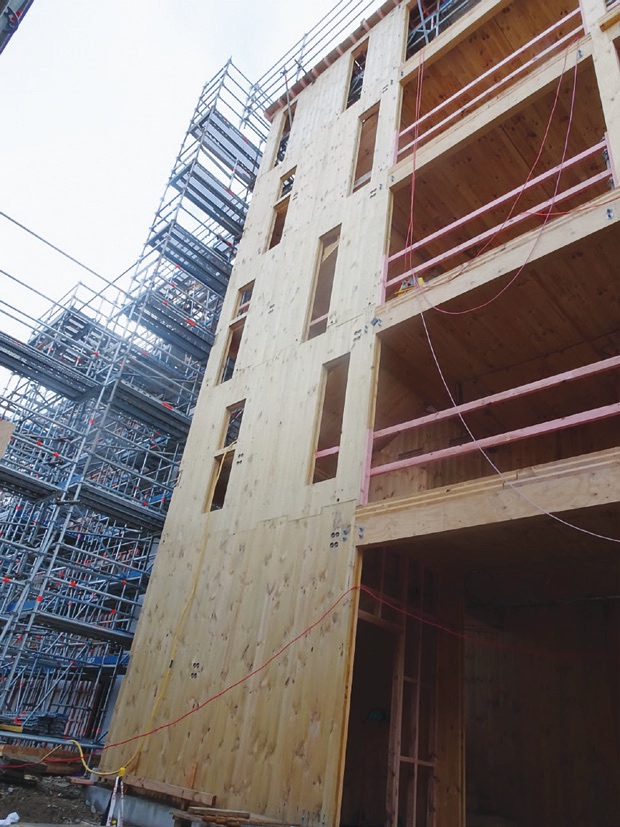
A medium-rise building constructed with cross laminated timber
The research team has more recently made good progress on testing the resilience in earthquakes, including work on fasteners and connection systems for the panels – the most critical aspect of seismic resilience.
Douglas-fir logs generally attract premium prices, but small diameter Douglas-fir logs have traditionally been harder to sell. This includes logs extracted in production thinning as well as short logs and top logs produced during conventional harvesting operations.
Small Douglas-fir logs were tested in making a new engineered wood product called optimised engineered lumber. The technology uses small pieces of timber to produce laminated, finger-jointed structural products with uniform and reliable properties. The tests were successful, and in future Douglas-fir optimised engineered lumber could provide the higher value market for small logs which growers are looking for. The technology has reached commercial stage in New Zealand, and radiata pine is already being used to make it.
Thermal modification to increase durability
Douglas-fir is not naturally durable which limits its applications. Thermal modification by heating wood to high temperature increases the durability of some types of wood. Therefore, in another project, Scion wood quality scientist Rosie Sargent ran some thermal modification tests on Douglas-fir. The results were encouraging, with increases in sapwood and heartwood durability following thermal modification. In the graph below, the increased durability of Douglas-fir is shown by the difference between the light blue and dark blue lines.
Some longer-term outdoor durability tests are now under way to investigate how the thermally modified Douglas-fir performs relative to products used for decking and cladding such as treated radiata pine and imported naturally durable softwoods and hardwoods. These tests will run for at least seven years, highlighting the long-term nature of this type of research.
Fungal decay of different timbers
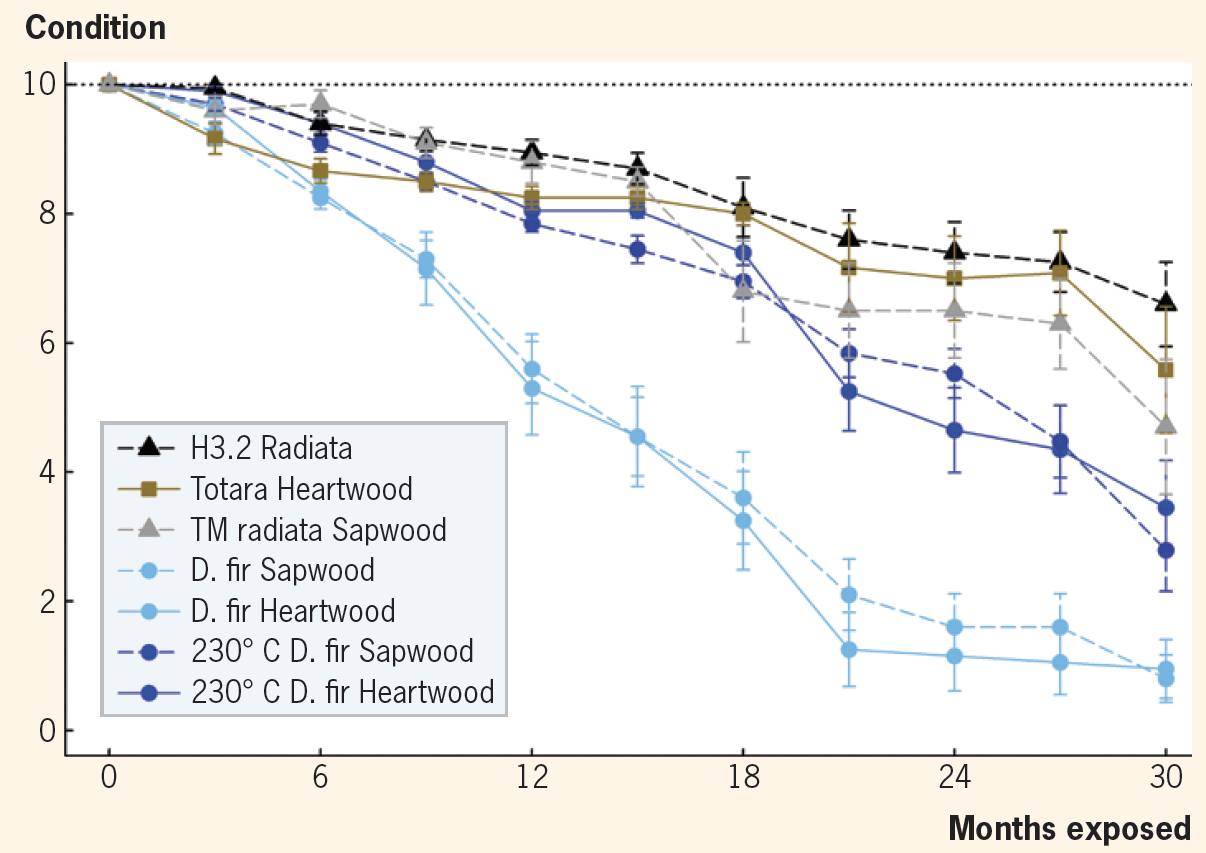
Modelling Douglas-fir growth
An early result was a new Douglas-fir GIS-based system which provides a high-resolution model of Douglasfir productivity and which can be imported into other mapping programmes. Scientists used permanent sample plot data along with high-resolution climate and soils data. The model marks a big step forward in understanding the interaction between Douglas-fir productivity and site conditions. The growth model used in the industry’s Forecaster calculator has been updated as a result.
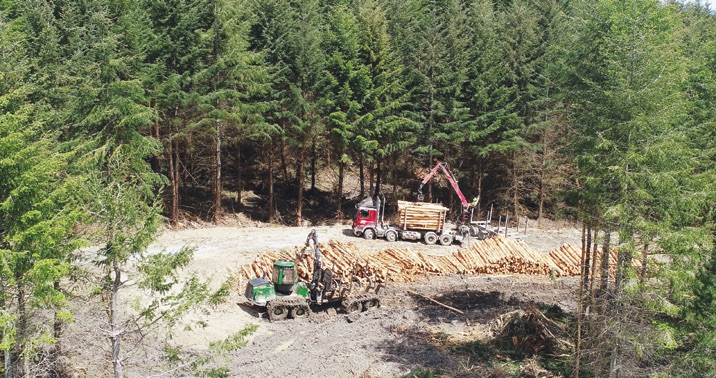
Production thinning in an Ernslaw One forest
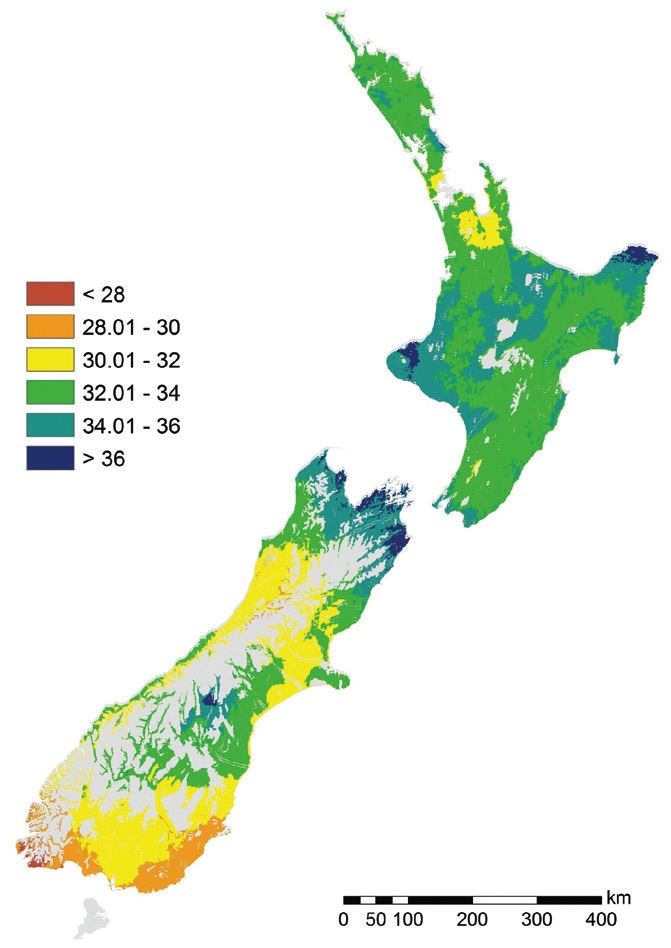
Modelling Douglas-fir productivity
Breeding advances
Back in 2016, a workshop led to Douglas-fir growers identifying new breeding targets:
- Growth - A 35-year rotation length, yield of 600 cubic metres of total recoverable volume per hectare with an average 20 cubic metre per hectare mean annual increment.
- Form - Maintain at the current level.
- Wood stiffness - Maintain at a minimum of 8 GPa.
- Needle retention - Three-year retention of needles, indicating improved tolerance to Swiss needle cast.
The Douglas-fir breeding plan was updated in 2017. Because of the threat of importing seed with pitch canker disease, all seedstock is now obtained from within New Zealand. New selections were made by Scion’s tree breeders from existing trials in 2018, targeting growth, wood quality and resistance to Swiss needle cast, and established on three sites.
Inevitably it will take some time for breeding gains to come to fruition, but once the new genetics come on stream, they should be available to all growers. Work on Douglas-fir genomics has also begun at Scion, using some additional funding. This creates the potential for much faster genetic gains than by conventional breeding.
Regional strategy and outlook
A regional Douglas-fir strategy was commissioned to review future regional wood flows and identify opportunities for investment in new processing. The strategy focused on Otago, Southland and the central North Island, where the trees are most plentiful.
Wood flow projections indicate that, at standard rotation lengths, there will be a big increase in harvest volumes from 2035 to 2045, especially in Southland. Following this spike, harvest volumes will level out. Wood flow beyond this time will depend on areas of replanting and new planting of Douglas-fir.
Because the spike in harvest volumes is of relatively short duration, the strategy concluded that regional investment in significant new processing capacity just for Douglas-fir could be difficult to justify. Three options
were identified as ways in which the industry can respond to the projected increase in wood flow:
- Process along with radiata pine, the same mill processing two different species. This already happens to some extent so is known to be possible and offers some potential.
- Grow some trees for longer to flatten out the supply spike.
- Export surplus logs if processing capacity is limited.
Despite the limited options identified, well-established Douglas-fir growers, especially those in the southern South Island believe the outlook for the species to be very bright. Douglas-fir can complement radiata pine and spread the increasingly recognised biosecurity and market risks associated with an all-radiata pine option. The species performs consistently well on colder, wetter and high-altitude sites unsuited to radiata. The domestic demand for structural timber is strong and likely to remain that way. Global demand for high-strength engineered wood products is increasing – a market where Douglas-fir has significant potential. Market settings may change, or other new opportunities appear. For example, as well as co-processing, new products made from more than one species may be developed.
The area of Douglas-fir in New Zealand has decreased slightly in recent years, with some growers replanting with radiata pine following Douglas-fir harvest. The two main disadvantages of Douglas-fir are its long rotation length compared to radiata pine, and its susceptibility to Swiss needle cast in warmer regions. The threat of wildings cannot be ignored and in some circumstances, growers will not have the option of planting Douglas-fir. Wilding prevention and management work is on-going in separate research programmes. For growers outside the main Douglas-fir growing regions, markets may be limited to export only.
Diversification
The new genetics due to come on-stream will solve some problems. If needle retention can be significantly increased, then central North Island growers’ interest in the species may well revive. Where growers are diversifying, Douglas-fir is now being used in combination with redwood on some sites, primarily as a nurse species but with the option of simply keeping the better tree when the time comes for thinning the mixed stands. By way of diversification, Blakely Pacific has recently added a new venture to its portfolio – producing high-value essential oils from purpose-grown Douglas-fir foliage.
New Zealand’s nett emissions targets and increasing carbon values are tipping the balance in favour of species with longer rotation. Douglas-fir, among other exotic species, offers a much faster carbon-sequestering
alternative than native species, has a lifespan of several centuries, and if harvested will be converted into products which will continue to lock up carbon for the long term.
Marco Lausberg is programme manager of the Specialty Woods Research Partnership.
Harriet Palmer is an independent forestry communications specialist.

 Farm Forestry New Zealand
Farm Forestry New Zealand